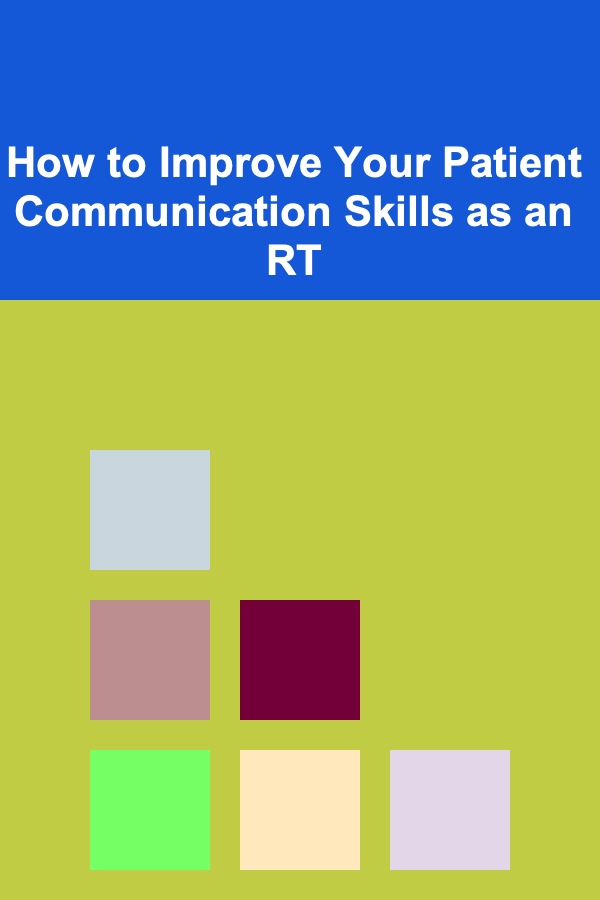
How to Improve Your Patient Communication Skills as an RT
ebook include PDF & Audio bundle (Micro Guide)
$12.99$11.99
Limited Time Offer! Order within the next:

As a respiratory therapist (RT), your role goes beyond simply providing medical treatments and interventions; it also involves effectively communicating with patients to ensure they understand their condition, treatment plan, and recovery goals. Excellent patient communication is essential for creating a positive therapeutic environment, fostering trust, reducing anxiety, and ultimately improving health outcomes.
Effective communication can significantly impact the quality of care patients receive. This article will delve into the importance of patient communication for respiratory therapists, the challenges faced, and practical strategies you can implement to enhance your communication skills.
The Importance of Effective Patient Communication
As an RT, you work closely with patients who are often dealing with respiratory distress, chronic illnesses, or post-surgical recovery. Effective communication is crucial in these situations for several reasons:
1. Building Trust and Rapport
Patients who feel heard and understood are more likely to trust their healthcare providers. As a respiratory therapist, your ability to listen to their concerns and provide clear information about their treatment can make a significant difference in their experience and recovery.
2. Reducing Anxiety and Stress
Respiratory conditions, especially those that involve shortness of breath or difficulty breathing, can be anxiety-inducing for patients. Good communication can alleviate some of that stress. By explaining procedures, calming their fears, and showing empathy, you can help patients feel more comfortable and confident in their care.
3. Enhancing Treatment Compliance
When patients understand the rationale behind their treatment and feel involved in decision-making, they are more likely to adhere to the prescribed therapies. Clear, empathetic communication helps patients grasp the importance of their treatments, whether it's oxygen therapy, pulmonary rehabilitation, or other respiratory interventions.
4. Improving Health Outcomes
Studies show that effective communication between healthcare providers and patients leads to better health outcomes. By fostering open lines of communication, RTs can identify potential concerns early, address misunderstandings, and adjust treatment plans as needed to promote healing.
Challenges to Effective Communication in Respiratory Therapy
Despite its importance, effective communication in healthcare can be challenging, especially in the field of respiratory therapy. Here are some common obstacles that RTs might face when trying to communicate with patients:
1. Patient Anxiety and Stress
Patients experiencing respiratory distress often struggle with anxiety and may have difficulty focusing or comprehending information. Shortness of breath, pain, and fear about their condition can hinder effective communication.
2. Language Barriers
Many patients speak languages other than English, which can create significant challenges in delivering clear and accurate information. This is particularly important in respiratory therapy, where patients must understand instructions for treatments like nebulizers, inhalers, and oxygen therapy.
3. Cognitive Impairments
Some patients may have cognitive impairments, whether due to age, illness, or medication, that can make it harder for them to understand instructions or retain information. For RTs, it's important to adjust communication methods to ensure that all patients can engage with their treatment plans.
4. Time Constraints
Healthcare professionals, including RTs, often work under time pressures, particularly in busy hospital settings. The demands of the job may make it challenging to spend the time necessary to thoroughly explain a treatment plan or to ensure that the patient fully understands the instructions.
5. Emotional or Behavioral Issues
Some patients may exhibit resistance, frustration, or even aggression, especially if they feel helpless or frightened about their condition. Effective communication requires the ability to manage these emotions and respond in a calm and empathetic manner.
Strategies to Improve Patient Communication Skills
Improving communication skills is a continuous process. As an RT, you can adopt several strategies to enhance your ability to engage with patients effectively, build trust, and improve outcomes. Let's explore some of the most important techniques:
1. Active Listening
One of the most essential aspects of communication is listening. Active listening involves fully concentrating on the patient's words, interpreting the meaning behind them, and responding thoughtfully. Here's how you can practice active listening:
- Give your full attention: When interacting with a patient, make eye contact, avoid distractions, and focus solely on them.
- Acknowledge their feelings: Nod, smile, and use verbal cues like "I see" or "That must be tough" to show that you understand their concerns.
- Ask clarifying questions: If the patient is not clear, ask open-ended questions to encourage them to share more information. This shows that you are engaged and genuinely interested in their well-being.
- Avoid interrupting: Let the patient finish speaking before you respond. This helps them feel respected and heard.
2. Be Empathetic
Empathy is the ability to understand and share the feelings of another person. For RTs, showing empathy is especially important when patients are struggling with difficult breathing situations. Here's how to demonstrate empathy:
- Validate their emotions: Recognize the patient's feelings, whether it's fear, frustration, or pain. Simple phrases like, "I can see that you're struggling," or "I understand that this is difficult for you," can make a significant impact.
- Show concern through actions: In addition to words, show empathy through your actions. Be gentle when handling patients, and take your time to make them feel comfortable.
- Offer reassurance: Patients dealing with respiratory issues may be scared about their health or recovery. Offer words of reassurance, such as, "We're doing everything we can to help you breathe easier," or "You're in good hands."
3. Simplify Medical Terminology
One of the most common barriers to effective communication is the use of complex medical language that may be difficult for patients to understand. As an RT, you must find ways to explain medical concepts in simple, easy-to-understand language.
- Avoid jargon: Instead of using technical terms like "spirometry" or "pulmonary function tests," try to explain them in layman's terms: "This test helps us see how well your lungs are working" or "We'll check how much air you can exhale in one breath."
- Use analogies: Analogies can help patients grasp complex concepts. For example, you might compare the lungs to a balloon: "When you breathe in, it's like filling up a balloon with air, and when you breathe out, it's like letting the air out."
- Ask for feedback: After explaining something, ask the patient to repeat it back in their own words to ensure they've understood.
4. Use Nonverbal Communication
In addition to verbal communication, nonverbal cues such as body language, facial expressions, and tone of voice play a crucial role in building rapport and conveying information effectively.
- Maintain open body language: Stand or sit at eye level with the patient, avoid crossing your arms, and use gestures to emphasize key points.
- Smile and be warm: A simple smile can go a long way in creating a positive environment for communication. It helps make you appear approachable and trustworthy.
- Be mindful of tone: The way you say something can affect how the patient perceives the message. Speak calmly and reassuringly, particularly when discussing treatment options or addressing concerns.
5. Engage in Patient Education
An essential part of communication is educating your patients about their conditions, treatments, and what they can do to improve their health. For RTs, educating patients about proper inhaler use, breathing exercises, and the importance of pulmonary rehabilitation is a key aspect of care.
- Provide clear instructions: When explaining treatments, use step-by-step instructions. For example, when teaching a patient how to use a nebulizer, demonstrate the process slowly, then ask the patient to show you how they would use it.
- Encourage questions: Create an open atmosphere where patients feel comfortable asking questions. Make it clear that no question is too small or insignificant.
- Offer written materials: Provide patients with written handouts or brochures to reinforce what you've explained during the session. This is especially helpful for patients who may have trouble remembering verbal instructions.
6. Be Patient and Calm
In high-pressure situations, such as when a patient is experiencing a respiratory crisis or anxiety, staying calm and patient is essential. Patients often take their emotional cues from healthcare providers. If you remain composed, it will help calm the patient and create a sense of security.
- Take deep breaths: Before entering a room with an anxious or distressed patient, take a few deep breaths to center yourself and approach the situation with a clear mind.
- Speak slowly and clearly: If a patient is in distress, they may have trouble processing information. Speaking slowly and clearly gives them time to understand and absorb what you're saying.
7. Practice Cultural Competence
Patients come from diverse cultural backgrounds, and cultural factors can significantly influence how they communicate and understand medical information. As an RT, it's important to be culturally sensitive and adapt your communication style to meet the needs of each patient.
- Ask about preferences: If you know that a patient speaks a different language or has specific cultural needs, make sure to accommodate those preferences. For instance, if you have an interpreter available, encourage its use to ensure accurate communication.
- Respect beliefs and values: Some patients may have specific beliefs regarding healthcare practices, such as avoiding certain treatments or medications. Respect these beliefs while still providing the best care possible.
Conclusion
Effective patient communication is at the heart of delivering high-quality respiratory care. As an RT, improving your communication skills will enhance your ability to build trust, reduce anxiety, and improve patient outcomes. By listening actively, showing empathy, simplifying medical language, using nonverbal communication, engaging in patient education, and practicing cultural competence, you can foster an environment of collaboration and understanding with your patients.
Remember that communication is a skill that can always be refined, and every patient interaction is an opportunity to improve your approach. By prioritizing clear, empathetic, and effective communication, you not only enhance your patients' experiences but also contribute to better health outcomes.
Reading More From Our Other Websites
- [Tie-Dyeing Tip 101] DIY Valentine's Gift: Tie-Dye a Heart on T-Shirts, Tote Bags, and More
- [Personal Care Tips 101] How to Choose the Best Fats for a Weight Loss Diet
- [Personal Financial Planning 101] How to Save Money: Smart Tips for Maximizing Your Savings
- [Personal Investment 101] How to Minimize Taxes on Your Investment Gains
- [Rock Climbing Tip 101] Eco-Friendly Climbing Gear: Sustainable Brands and Materials to Watch
- [Home Budget Decorating 101] How to Decorate with Plants on a Budget
- [Home Budget Decorating 101] How to Create a Boho Chic Look in Your Home on a Budget
- [Home Budget 101] How to Use Apps to Help You Stick to Your Home Budget
- [Home Security 101] How to Secure Your Home from Natural Disasters
- [Organization Tip 101] How to Utilize Under-Bed Storage for Maximum Efficiency

How to Avoid Lifestyle Inflation and Keep Your Finances in Check
Read More
How to Coordinate Entertainment Options for Various Events
Read More
How to Involve Kids in the Meal Prep Process
Read More
How to Organize a Virtual Party for Remote Guests
Read More
How to Bake for a Crowd
Read More
How to Identify Deep-Sea Fish Species
Read MoreOther Products

How to Avoid Lifestyle Inflation and Keep Your Finances in Check
Read More
How to Coordinate Entertainment Options for Various Events
Read More
How to Involve Kids in the Meal Prep Process
Read More
How to Organize a Virtual Party for Remote Guests
Read More
How to Bake for a Crowd
Read More